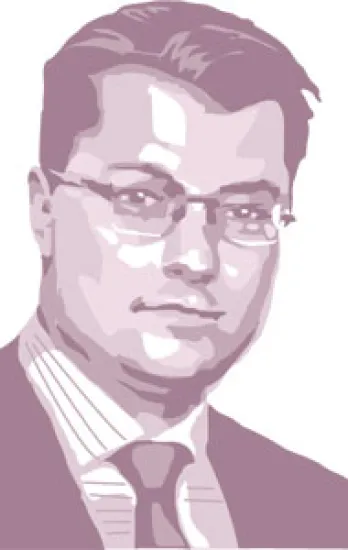[Links to profiles of the 2009 All-Russia Research Team winners in each sector are available at the end of this article.]
Markets around the world have been on a wild ride for the past year or so, but few rides have been as riotous as Russia’s. The benchmark Russian Trading System index plunged 72.4 percent in 2008, only to surge 31.8 percent in the first four months of 2009. Real gross domestic product growth shot up to 9 percent year-over-year in the first quarter of 2008 but then tumbled to negative 9.5 percent just one year later. Inflation soared to 13.8 percent last year and unemployment jumped nearly 50 percent, to 9.5 percent.
Despite high inflation, high unemployment and concerns that the economy will continue to contract at least through the second quarter, optimism abounds in Russia. Last month, thanks to rising oil prices and rekindled investor interest in Russian equities, the RTS index closed above the psychologically important 1,000-point level (it had fallen as low as 498.20 in January), prompting many analysts to declare that the worst is over.
Investors returning to Russia want reassurance that the rally is sustainable and are looking for direction on which sectors of the economy are likely to enjoy the most robust growth. Many of the analysts who do the best job of providing that guidance can be found at Renaissance Capital, according to participants in the 2009 All-Russia Research Team survey, Institutional Investor’s sixth annual ranking of Russia’s leading securities researchers.
RenCap takes top honors for a sixth consecutive year, but by a narrow margin over second-place Troika Dialog: The firms capture 14 and 13 total team positions, respectively. Deutsche Bank rises one notch to third place, with five team positions. UBS and UniCredit Research tie for No. 4, with four positions each. Results are based on responses from more than 300 investors at 240 institutions worldwide managing an estimated $111 billion in Russian assets.
Many analysts and economists admit to having been blindsided by the swiftness and severity of Russia’s economic downturn. Thanks largely to skyrocketing oil prices, Russia was barely buffeted in the first year of the global financial storm, which began in the summer of 2007 with the collapse of the U.S. subprime mortgage market. The nation’s resilience appeared to lend credence to the theory that Russia had decoupled from the U.S. economy and would continue to thrive despite the turmoil in the West. But not long after oil prices began to plummet last summer and Lehman Brothers Holdings filed for bankruptcy in September, freezing credit markets around the world, Russia’s stock market went into a tailspin, and the decoupling theory was laid to rest.
“The most significant challenge was coping with systemic shock on many levels,” explains Yaroslav Lissovolik, director of Russian equity research at Deutsche Bank, who ranks third in Economics. “Our local teams had to fine-tune their research operations within the global framework.”
Analysts had to set aside their assumptions about decoupling and correlate their coverage with developments in other parts of the world. “Almost on a daily basis, we had to be listening to what the U.S. chief economist or the global strategist in London had to say,” Lissovolik recalls. “In my economic presentations to investors, I had to include an aside on exchange rates and developments in commodities prices and how that affects Russia’s current account balance and government deficits.”
He and other research directors also had to grapple with the severe pressure on their firms’ bottom lines, which meant eliminating analyst positions and scaling back coverage in the face of what was projected to be a prolonged downturn. The situation at Deutsche was particularly volatile. In March 2008 rival VTB Capital, which ties for seventh place this year with J.P. Morgan Securities, enticed ten senior analysts away from the German bank. Lissovolik immediately began replacing the lost analysts and had just restored his department to a full complement of 18 when the market collapsed, forcing him to shift from hire mode to fire mode.
“We had the exodus in the first half of the year and then cuts in the second half,” he says. “But we’ve still managed to cover the main sectors.” Deutsche is one of the few firms to have increased coverage over the past year, from 70 stocks to 81.
RenCap slashed its analyst head count from 65 to 38 and reduced its coverage from 250 stocks to 165. Roland Nash, the firm’s head of equity research and the top-ranked analyst in Equity Strategy for a sixth consecutive year, says it was inevitable that the number of analysts would have to be pruned, particularly as trading volume plummeted by two thirds over the past year.
“Analysts make money according to turnover in the market, so you’re going to have to cut staff by at least 50 percent on that score alone,” he explains. In addition, “many Russian companies have gone bankrupt, and there’s been some merger-and-acquisition activity as well,” he says, so there are fewer stocks to follow.
Troika cut its team from 36 to 28 analysts. “The volume of our business is off 30 to 50 percent from this time last year,” says Paolo Zaniboni, Troika’s head of equity research. “We’re still committed to the depth and breadth of coverage, and we’re still covering 160 to 180 stocks.” But, he adds, the firm has to be more strategic in its deployment of newly constrained resources. Troika recently began publishing “News from the Fields,” which provides investors with updates on industries such as mining and agriculture based in far-flung regions of the country.
“There’s been very little information coming out of the regions, and this allows for a complete understanding of how the crisis is affecting different parts of Russia,” Zaniboni says.
UBS has taken a different tack, offering greater detail about the debt loads of the 79 companies its analysts follow. “Investors have been more interested in the amount of leverage of the corporates because of the changed credit market environment,” says Alexei Morozov, who is the Swiss bank’s co-director of Russian equity research, with Dmitry Vinogradov.
UniCredit reduced its coverage from 100 stocks to 80 “to focus on the blue chips, because clients aren’t interested in illiquid second- and third-tier names,” explains Benjamin Carey, who is co-director of research with Julia Bushueva. But the firm opted not to reduce its analyst head count so that it would be well positioned for a rebound.
“Several of our competitors overreacted and cut analysts in the fourth quarter of last year and the first quarter of this year, and now they can’t catch the turnaround,” Carey says. “We’ve had an opportunity to increase market share, but you’re looking at a larger share of smaller pie.
The analysts who do the best job of providing exactly that kind of information can be found on our annual ranking of the All-Russia Research Team. To view profiles of the winners, click on a specific sector below.
Industries
Macro
Fixed-Income






